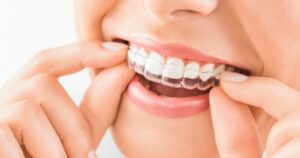Welcome to My Smile Orthodontist, where your journey to a confident and healthy smile begins. We understand that achieving the perfect smile requires a comprehensive approach, and that’s why we’re here to guide you through every step of your orthodontic treatment. In this article, we’ll delve into a crucial aspect of orthodontics – the use of elastics, often referred to as rubber bands.
Orthodontic treatment has come a long way, and today, it’s not just about braces. Elastics, or rubber bands, are a fundamental component of modern orthodontic care. They play a significant role in helping patients achieve the smile they’ve always dreamed of. Whether you’re a current patient looking for more information or someone considering orthodontic treatment, understanding the role of elastics is essential.
So, let’s embark on a journey to uncover the importance of elastics in orthodontic treatment. We’ll explore what they are, why they are used, how to wear them, and their positive impact on your orthodontic progress. By the end of this article, you’ll have a clearer picture of how elastics contribute to your beautiful, healthy smile. Let’s get started.
Understanding Elastics
Elastics, commonly referred to as rubber bands, are a crucial element of orthodontic treatment. These small, but mighty, tools play a significant role in guiding your teeth into their desired positions and aligning your bite correctly. Let’s dive deeper into understanding the role of elastics in orthodontics.
What Are Orthodontic Elastics?
Orthodontic elastics are small, stretchy rubber bands that come in various sizes and strengths. They are typically made from medical-grade latex or latex-free materials to ensure compatibility with patients who may have latex allergies. These elastics are designed for use with braces and are a key component of many orthodontic treatment plans.
Why Are They Used?
The primary purpose of orthodontic elastics is to create the necessary forces that move your teeth into their ideal positions. While braces are excellent at straightening teeth, they may not be enough to correct certain bite issues and tooth misalignments entirely. This is where elastics come in.
Elastics are strategically placed on your braces to apply pressure to specific teeth or groups of teeth. The tension generated by the elastics helps shift the teeth, align the bite, and achieve optimal jaw alignment. Essentially, they provide the additional “push” needed to fine-tune your smile and bite.
Types of Elastics
Orthodontic elastics come in a variety of sizes, shapes, and strengths. The type of elastics prescribed by your orthodontist will depend on your unique treatment needs. Here are some common types of elastics:
Interarch Elastics
These elastics connect the upper and lower arches of your braces, helping to correct bite issues such as overbites or underbites.
Intramaxillary Elastics
These are used to correct alignment issues within the same arch. They can help with rotations, spacing, or other misalignments of individual teeth.
Rubber Bands for Braces
These are the most commonly used elastics, and they come in various sizes and strengths. Your orthodontist will specify the size and configuration needed for your treatment.
Class II and Class III Elastics
These are used to correct more complex bite issues, such as severe overbites (Class II) or underbites (Class III).
How Do They Work?
Elastics work by applying consistent pressure on the teeth they are connected to. This pressure gradually moves the teeth in the desired direction. Your orthodontist will provide detailed instructions on how to wear your elastics, including when to change them and how often to wear them.
It’s crucial to follow your orthodontist’s guidance meticulously when it comes to wearing elastics. Consistency is key to achieving the best results. While it may take a little time to get used to wearing elastics, the payoff in terms of a beautifully aligned smile is more than worth it.
In the next sections, we’ll explore the practical aspects of wearing elastics, how to care for them, and the benefits they bring to your orthodontic journey. So, if you’re curious about what it’s like to have elastics as part of your orthodontic treatment, keep reading to learn more.
Types of Elastics
Orthodontic elastics, often called rubber bands, come in various types, each serving a specific purpose in aligning your teeth and bite. Understanding the different types of elastics prescribed by your orthodontist is essential for effective treatment. Here are the most common types:
Interarch Elastics
These elastics are used to correct bite discrepancies, such as overbites or underbites. They connect the upper and lower arches of your braces, exerting the necessary force to align your jaws properly. Interarch elastics are crucial for achieving a harmonious bite.
Intramaxillary Elastics
Unlike interarch elastics, intramaxillary elastics are used within the same arch. They work to address specific tooth alignment issues, such as rotations, spacing, or misalignments of individual teeth. Your orthodontist will determine if intramaxillary elastics are needed based on your treatment plan.
Rubber Bands for Braces
These are the most commonly used elastics in orthodontic treatment. They come in various sizes and strengths, allowing for customization to suit your specific needs. These rubber bands connect hooks on your braces, exerting pressure to move teeth in the desired direction. Your orthodontist will provide instructions on how to wear them and when to change them.
Class II and Class III Elastics
These specialized elastics are used for more complex bite issues. Class II elastics help correct severe overbites, while Class III elastics address significant underbites. They play a crucial role in guiding the jaw into the correct position and improving bite alignment.
Selecting the Right Type
The type of elastics prescribed for your orthodontic treatment depends on the specific issues that need correction. Your orthodontist will carefully assess your dental condition and develop a treatment plan tailored to your needs. This plan will include the type of elastics, their configuration, and the recommended wear schedule.
Wearing Elastics
Consistency is vital when it comes to wearing elastics. Following your orthodontist’s instructions on when and how to wear them is crucial for achieving the desired results. While it may take some time to adjust to wearing elastics, their effectiveness in moving teeth and aligning your bite makes them an essential part of your orthodontic journey.
In the next sections, we’ll explore the practical aspects of wearing elastics, how they work in conjunction with your braces, and the benefits they offer. Understanding the role of elastics in your treatment will help you make the most of your orthodontic experience.
Why Are Elastics Used?
Orthodontic elastics, or rubber bands, play a vital role in many orthodontic treatments. They serve several essential functions, contributing to the overall success of your orthodontic journey. Here are the primary reasons why elastics are used:
Bite Correction
Elastics are often used to address bite problems, such as overbites, underbites, crossbites, and open bites. They help align the upper and lower jaws correctly, ensuring that your teeth fit together harmoniously when you bite or chew.
Tooth Alignment
Elastics are effective in moving individual teeth. They can close gaps between teeth, correct rotations, and resolve other alignment issues. Your orthodontist may use elastics in combination with other orthodontic appliances to achieve precise tooth positioning.
Braces Adjustment
In cases where traditional braces are used, elastics provide additional forces to shift teeth into their desired positions. They work in tandem with the brackets and wires, facilitating controlled tooth movement.
Customized Treatment
Orthodontic elastics come in various sizes and strengths. This allows for highly customized treatment plans. Your orthodontist will select the right type and configuration of elastics tailored to your specific needs, ensuring efficient and effective treatment.
Jaw Realignment
For patients with significant jaw discrepancies, elastics help guide the jaw into a more balanced and functional position. This is particularly important for enhancing both the aesthetics and functionality of your smile.
Consistent Progress
Wearing elastics as prescribed by your orthodontist ensures consistent progress throughout your treatment. They provide the necessary force to move teeth, maintain alignment, and achieve the desired results.
Treatment Efficiency
Elastics are an integral part of many orthodontic treatments, as they can help reduce overall treatment time. By following your orthodontist’s instructions and consistently wearing elastics, you can contribute to the efficiency of your treatment.
Enhanced Comfort
Correcting bite and alignment issues often results in improved comfort and functionality. Elastics can alleviate discomfort associated with misaligned teeth and jaws, allowing you to enjoy a better quality of life.
It’s important to note that the use of orthodontic elastics requires strict adherence to your orthodontist’s instructions. Consistency in wearing elastics and replacing them as directed is essential for achieving the desired outcomes. Your orthodontic team will provide guidance on the proper care and maintenance of elastics to ensure your treatment progresses smoothly.
How to Wear Elastics
Wearing orthodontic elastics, often referred to as rubber bands, is a crucial aspect of many orthodontic treatments. Proper use of elastics contributes to the success of your orthodontic journey. Here’s a step-by-step guide on how to wear and care for your elastics:
Understanding Your Prescription
Your orthodontist will provide a specific prescription for your elastics. This includes details on which teeth to attach them to and when to wear them (e.g., daytime, nighttime, or both). Follow this prescription diligently.
Size and Configuration
Orthodontic elastics come in various sizes, colors, and configurations. Your orthodontist will choose the appropriate type of elastics tailored to your treatment needs. It’s essential to use the elastics provided by your orthodontic team.
Clean Hands
Before handling elastics, make sure your hands are clean. Wash them with soap and water to avoid transferring bacteria to your mouth.
Use a Mirror
It’s often easier to use a mirror to guide you when placing elastics. This ensures they are correctly attached to the designated teeth and hooks.
Attaching Elastics
Gently stretch the elastic over the hooks or attachments on your braces. Follow your orthodontist’s instructions regarding the specific teeth where the elastics should be placed. There are typically upper and lower elastics, and they form various configurations, such as triangles or squares. Ensure you understand how to attach them correctly.
Consistent Wear
Wear your elastics as instructed by your orthodontist. Consistency is key to achieving the desired results. If you’re advised to wear elastics full time (24/7), only remove them for eating, brushing, and flossing.
Change Them Regularly
Elastics lose their elasticity over time, reducing their effectiveness. Change them as recommended by your orthodontist, which is usually every 12 hours or as directed.
Carry Spares
It’s a good idea to carry spare elastics with you, especially when you’re away from home. If one breaks or becomes loose, you can quickly replace it to maintain consistent treatment progress.
Proper Removal
When it’s time to remove your elastics, do so gently. Start by removing the elastic from one side and then the other. Avoid snapping or flicking them off, as this can cause discomfort.
Oral Hygiene
Don’t forget about your oral hygiene routine. Brush your teeth thoroughly, including around the hooks and attachments where the elastics are placed. Flossing is equally important to remove food particles and plaque.
Stay Committed
Orthodontic treatment requires commitment. Consistently wearing your elastics as prescribed will help ensure your treatment progresses on schedule. Any deviations can potentially lengthen the treatment time.
Communication
If you have questions or experience issues with your elastics, don’t hesitate to reach out to your orthodontic team. They can provide guidance and address any concerns.
Remember that the success of your orthodontic treatment depends on your active participation. By following your orthodontist’s instructions for wearing and caring for elastics, you play an essential role in achieving the desired alignment and bite correction. If you ever have uncertainties or encounter problems, consult with your orthodontic team for assistance.
Potential Discomfort
It’s entirely normal to experience some discomfort when you first start wearing orthodontic elastics. This discomfort typically subsides after a few days as you get used to the sensation. Here are some things to keep in mind:
Initial Soreness
When you begin wearing elastics or switch to a new configuration, you may feel some initial soreness or tension. This is because the elastics are actively working to move your teeth. Over-the-counter pain relievers like ibuprofen can help alleviate this soreness. However, always consult your orthodontist before taking any medication.
Regular Wear
Consistent wear is crucial for effective treatment. If you skip wearing your elastics or only wear them occasionally, you may experience more discomfort when you put them back on. To minimize discomfort, follow your orthodontist’s instructions precisely.
Elastic Changes
Your orthodontist will periodically adjust the configuration and strength of your elastics to facilitate tooth movement. This might cause temporary discomfort, but it’s a sign that your treatment is progressing.
Rubber Band Breakage
Occasionally, elastics may break. This can be uncomfortable, especially if the band snaps against your cheek or tongue. Always carry spare elastics and replace any broken ones promptly.
Maintenance and Oral Hygiene
Proper oral hygiene is essential when wearing elastics. Food particles can get caught in the bands, leading to discomfort or even decay. Brushing and flossing meticulously around your braces and elastics will help prevent this.
Tissue Irritation
In some cases, elastics can irritate the soft tissues inside your mouth, such as your cheeks or lips. Orthodontic wax can be applied to the brackets and hooks to reduce friction and alleviate discomfort.
Communicate with Your Orthodontist
If you experience persistent or severe discomfort, or if you have concerns about your elastics, don’t hesitate to reach out to your orthodontic team. They can provide guidance and make any necessary adjustments to ensure your treatment is as comfortable as possible.
Orthodontic Progress with Elastics
As you wear elastics diligently and follow your orthodontist’s instructions, you’ll begin to notice the remarkable progress in your orthodontic treatment. Elastics play a crucial role in aligning your teeth and correcting your bite. Here’s what you can expect as your treatment advances:
Improved Alignment
Elastics exert gentle but consistent pressure on your teeth, guiding them into their ideal positions. Over time, you’ll notice your teeth becoming straighter and more evenly spaced. This improved alignment not only enhances your smile but also contributes to better oral health.
Enhanced Bite
If you had issues with your bite, such as an overbite or underbite, elastics work to correct these problems. You’ll gradually achieve a more balanced and functional bite, which is essential for comfortable chewing and speaking.
Faster Treatment
The use of elastics in conjunction with braces or clear aligners can often lead to a shorter overall treatment time. This means you’ll be able to enjoy your beautifully aligned smile sooner.
Increased Comfort
As your bite improves, you may find that any discomfort or pain associated with misaligned teeth or bite issues diminishes. Many patients report improved comfort and reduced jaw tension as their treatment progresses.
Clearer Speech
If your orthodontic issues affected your speech, you’ll likely notice significant improvements. Properly aligned teeth and a well-balanced bite can lead to clearer and more confident speech patterns.
Positive Feedback
One of the most rewarding aspects of orthodontic treatment is the positive feedback you’ll receive from others. Friends and family will start noticing the transformation of your smile, which can boost your self-esteem and confidence.
Regular Adjustments
Throughout your orthodontic journey, your orthodontist will continue to assess your progress and make necessary adjustments to your elastic configuration. This ensures that your treatment stays on track and that your teeth continue to move in the right direction.
Personalized Care
Your orthodontist will tailor your treatment plan to address your unique needs and goals. This personalized approach ensures that you receive the most effective and comfortable orthodontic care possible.
Maintaining Elastic Wear
Consistency is key when it comes to elastic wear. Follow your orthodontist’s recommendations diligently to achieve the best results. If you ever have questions or encounter issues, don’t hesitate to reach out to your orthodontic team for guidance.
In summary, elastics are a vital component of orthodontic treatment, helping to align your teeth, improve your bite, and enhance your overall oral health. The progress you’ll experience as you wear elastics is a testament to the effectiveness of modern orthodontics. Embrace the journey, and you’ll soon enjoy the numerous benefits of a beautifully aligned smile.
Consulting My Smile Orthodontist
If you’re considering orthodontic treatment or have questions about elastics, the team at My Smile Orthodontist is here to provide expert guidance and support. We understand that every patient’s needs are unique, and we’re dedicated to delivering personalized care to help you achieve the smile you’ve always wanted.
Here’s what you can expect when you consult My Smile Orthodontist:
Comprehensive Assessment
Our experienced orthodontic specialists will conduct a thorough evaluation of your oral health and orthodontic needs. We’ll use advanced diagnostic tools, such as X-rays and digital scans, to create a detailed picture of your dental condition.
Personalized Treatment Plan
Based on our assessment, we’ll create a customized treatment plan tailored to your specific goals. This plan may include the use of elastics as part of your orthodontic journey.
Elastic Configuration
We’ll explain the role of elastics in your treatment and demonstrate how to wear them properly. You’ll receive clear instructions and guidance on when and how to change your elastics.
Open Communication
At My Smile Orthodontist, we prioritize clear and open communication. Feel free to ask any questions or express concerns you may have about your treatment. We’re here to listen and provide answers to ensure you’re comfortable with your orthodontic plan.
Regular Check-Ups
Throughout your treatment, we’ll schedule regular check-up appointments to monitor your progress. These visits allow us to make any necessary adjustments to your treatment plan and ensure that you’re on track to achieve the best results.
Patient Education
We believe that informed patients make the best decisions about their orthodontic care. Our team will educate you about the benefits of elastics and how they contribute to your treatment goals. We’ll also provide tips on maintaining good oral hygiene while wearing braces and elastics.
Supportive Environment
My Smile Orthodontist is committed to creating a supportive and friendly environment for our patients. We understand that orthodontic treatment can be a significant journey, and we’re here to make it as comfortable and successful as possible.
When you choose My Smile Orthodontist, you’re choosing a team of dedicated professionals who are passionate about helping you achieve a healthy, beautiful smile. Contact us today to schedule a consultation and take the first step toward a confident and radiant smile.
Conclusion
In the world of orthodontics, elastics, or rubber bands, play a vital role in helping patients achieve beautiful, functional smiles. These tiny, but powerful, components are part of a broader treatment strategy designed to address a variety of dental issues.
At My Smile Orthodontist, we understand that the decision to undergo orthodontic treatment, including the use of elastics, is a significant step towards a healthier and more confident smile. We hope this comprehensive guide has shed light on the importance of elastics in orthodontic treatment and answered any questions you may have had.
Remember, elastics are a versatile tool used by orthodontists to correct bite problems, align teeth, and achieve a harmonious smile. Their effectiveness relies on consistent wear and proper care. Following your orthodontist’s instructions diligently is essential to ensure the best possible outcome.
If you’re considering orthodontic treatment or have specific questions about elastics, we encourage you to consult the experienced team at My Smile Orthodontist. Our commitment to personalized care, cutting-edge technology, and a patient-centered approach ensures that you’ll receive the highest quality orthodontic treatment available.
Take the first step towards your dream smile and reach out to My Smile Orthodontist for a consultation. We’re here to guide you on your orthodontic journey, answer your questions, and provide the support you need to achieve a healthier, more confident smile. Your smile transformation begins here.













